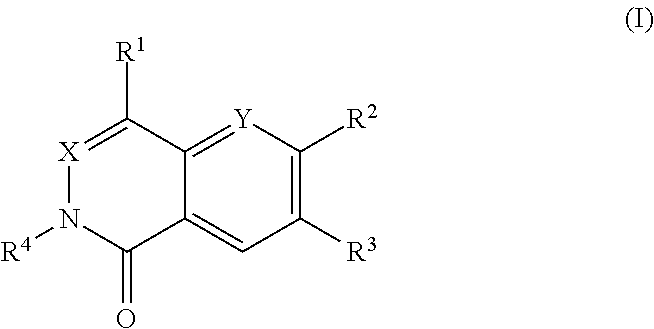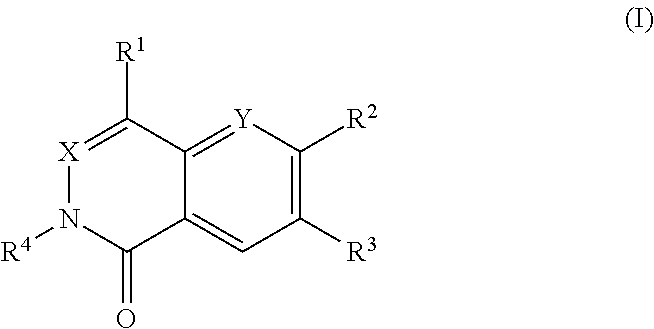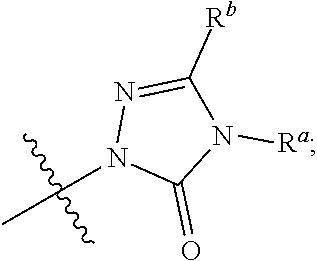Dihydroorotate dehydrogenase inhibitors
a technology of dihydroorotate and inhibitors, applied in the field of compound, can solve the problems of reducing the formation of hematopoietic cells, refractory and relapsed disease remains a challenge, and is applicable to a small population of aml patients
- Summary
- Abstract
- Description
- Claims
- Application Information
AI Technical Summary
Benefits of technology
Problems solved by technology
Method used
Image
Examples
examples
[0292]In obtaining the compounds described in the examples below and the corresponding analytical data, the following experimental and analytical protocols were followed unless otherwise indicated.
[0293]Unless otherwise stated, reaction mixtures were magnetically stirred at room temperature (rt) under a nitrogen atmosphere. Where solutions were “dried,” they were generally dried over a drying agent such as Na2SO4 or MgSO4. Where mixtures, solutions, and extracts were “concentrated”, they were typically concentrated on a rotary evaporator under reduced pressure.
[0294]Normal-phase silica gel chromatography (FCC) was performed on silica gel (SiO2) using prepacked cartridges.
[0295]Preparative reverse-phase high performance liquid chromatography (RP HPLC) was performed on either:
METHOD A. A Gilson GX-281 semi-prep-HPLC with Phenomenex Synergi C18 (10 μm, 150×25 mm), or Boston Green ODS C18 (5 μm, 150×30 mm), and mobile phase of 5-99% ACN in water (with 0.225% FA) over 10 min and then hol...
example 2
l-3-(hydroxymethyl)-5-oxo-4,5-dihydro-1H-1,2,4-triazol-1-yl)-2-(3-fluorophenyl)-4-isopropylisoquinolin-1(2H)-one
[0355]
[0356]To a solution of 6-(4-ethyl-3-(hydroxymethyl)-5-oxo-4,5-dihydro-1H-1,2,4-triazol-1-yl)-2-(3-fluorophenyl)-4-(prop-1-en-2-yl)isoquinolin-1(2H)-one (35 mg, 0.08 mmol) in methanol (5 mL) was added Pd / C (18 mg, 10%). The mixture was degassed and purged with hydrogen gas for 3 times. The reaction mixture was then stirred under hydrogen atmosphere (15 psi) at 25° C. for 12 h. The mixture was filtered through a short pad of Celite®. The filtrate was concentrated. The residue was purified by prep-HPLC (C18 column, 10-90% gradient ACN in water) to afford the title compound as a white solid (8 mg, yield 42%). LCMS (ES-API): mass calcd. for C23H23FN4O3, 422.2; m / z found, 423.1 [M+H]+. 1H NMR (400 MHz, DMSO-d6) δ 8.51 (s, 1H), 8.41 (d, J=8.84 Hz, 1H), 8.13 (br d, J=8.84 Hz, 1H), 7.54-7.64 (m, 1H), 7.28-7.41 (m, 3H), 7.20 (s, 1H), 4.54 (s, 2H), 3.76-3.87 (m, 2H), 3.16-3.28 ...
example 3
ro-6-fluorophenyl)-6-(4-ethyl-3-(hydroxymethyl)-5-oxo-4,5-dihydro-1H-1,2,4-triazol-1-yl)-4-isopropylisoquinolin-1(2H)-one
[0357]
Step A. N-(2-Chloro-6-fluorophenyl)-3-methylbut-2-en-1-imine
[0358]To a solution of 2-chloro-6-fluoroaniline (2.9 g, 20 mmol) and 3-methyl-2-butenal (2 g, 23.9 mmol) in anhydrous dichloromethane (50 mL) at 0° C. was added triethylamine (8.3 mL, 60 mmol), followed by the addition of TiCl4 (3 g, 16 mmol) dropwise. The reaction mixture was stirred at 0° C. for 1 h, then warmed to 25° C. and stirred for 4 h. The mixture was filtered through a short pad of Celite®, and the filtrate was partitioned between dichloromethane and water. The organic layer was separated, and the aqueous layer was extracted with dichloromethane. The combined organic extract was dried over MgSO4, filtered, and concentrated to give the crude desired product as a yellow oil (3.3 g, 78%), which was used crude in the next step without further purification. 1H NMR (400 MHz, CDCl3) δ 8.36 (dd, J...
PUM
 Login to View More
Login to View More Abstract
Description
Claims
Application Information
 Login to View More
Login to View More - R&D Engineer
- R&D Manager
- IP Professional
- Industry Leading Data Capabilities
- Powerful AI technology
- Patent DNA Extraction
Browse by: Latest US Patents, China's latest patents, Technical Efficacy Thesaurus, Application Domain, Technology Topic, Popular Technical Reports.
© 2024 PatSnap. All rights reserved.Legal|Privacy policy|Modern Slavery Act Transparency Statement|Sitemap|About US| Contact US: help@patsnap.com










